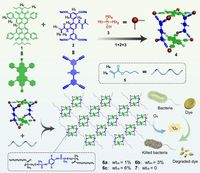A novel strategy to combat water pollution has emerged from new research conducted by scientists at Xi'an Jiaotong University, addressing a critical global challenge that threatens public health and environmental sustainability. The team has developed metallacage-crosslinked supramolecular networks via photo-induced copolymerization, which demonstrate remarkable efficiency in decontaminating water by effectively removing diverse organic pollutants and killing bacteria.
The global water crisis is worsening, with predictions indicating that water scarcity could reach 40% by 2030 and demand escalating by 55% in the years leading up to 2050. These alarming projections have prompted researchers to seek innovative solutions for water treatment technologies. Traditional methods, while effective, often suffer from limitations such as high costs and slow processing times. In contrast, the new photocatalytic approach introduced in this study offers a speedy and efficient method for water purification.
Using photo-induced copolymerization, the researchers successfully created free-standing polymer networks integrating specific metallacages designed for optimal photocatalytic activity. These metallacages not only facilitate the efficient generation of singlet oxygen, a potent reactive species for decomposing contaminants but also enhance the stability and processability of the resulting polymer networks.
Details of the process were well-documented, showing that the synthesized metallacage 4 was produced with a notable yield of 93%. This metallacage features three key absorption bands at 458 nm, 490 nm, and 526 nm, with excellent photophysical properties contributing to its role as a photocatalyst. "This study not only provides a mild and effective strategy for the preparation of metallacage-cored supramolecular networks via photo-induced copolymerization but also explores their applications for photocatalytic dye degradation and bacterial killing," wrote the authors of the article.
The efficacy of these networks was assessed by testing their performance in degrading various industrial dyes and eliminating bacterial contaminants. Results showed that the networks significantly improved the degradation rates of pollutants in wastewater, achieving remarkable efficiencies across different dye types. Furthermore, these networks exhibited considerable antibacterial properties, effectively killing harmful bacteria such as Escherichia coli and Staphylococcus aureus under light irradiation.
One of the significant advantages of these newly developed polymeric networks is their potential for reuse. The study demonstrated that these materials can maintain performance across multiple cycles without a noticeable drop in effectiveness, showcasing their durability crucial for practical applications.
Additional tests involving plant irrigation revealed further benefits of using purified water produced by these networks. When plants were grown with the treated water, they exhibited improved growth and vitality, suggesting that the decontamination process not only cleans the water but also fosters better agricultural outcomes. The purified water from the study allowed plants to grow approximately 25 cm after a week, surpassing those watered with untreated wastewater.
As researchers continue to refine these metallacage-based materials, the implications for future studies and applications in environmental science are substantial. The potential for scaling this technology could lead to more sustainable water treatment solutions, addressing global water quality challenges effectively.
In conclusion, the innovative application of photocatalytic polymer networks presents a promising advancement in water decontamination methods, facilitating a dual function of pollutant degradation and bacterial disinfection. As water scarcity continues to threaten populations worldwide, this research underscores the urgent need for continued exploration in material science dedicated to environmental preservation and public health improvement.




